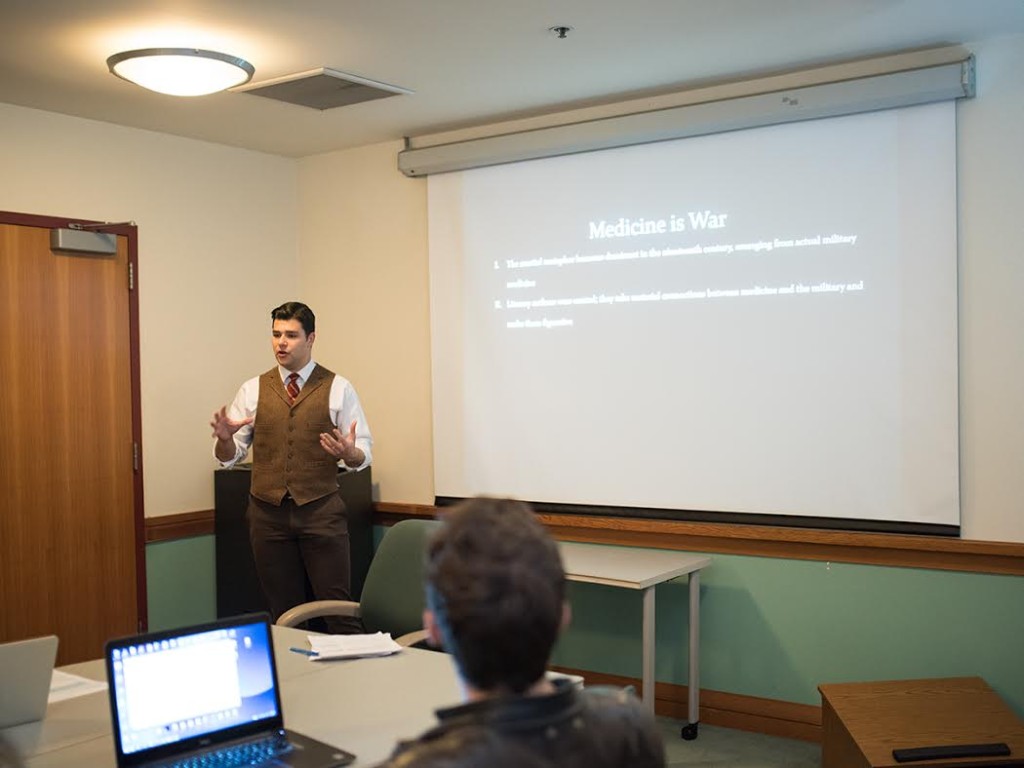
Most college lectures focus on one specific subject for the purpose of benefitting students within that field of study. For example, one can assume that a math major would have blundered if they attend a “Math Used in Music Theory” lecture, and it would be equally confusing for a theater major to learn about “The Latent Causes of Behavior” that only psychology majors would understand.
However, there is a point in which two completely distinct subjects can be taught in unison because the unique occasion intertwined them. This was the case with Arthur Conan Doyle and the Imperial Aramanateriam.
On Jan. 20, 2016, students from different disciplines and backgrounds gathered in a small yet cozy conference room in Humanities and Social Sciences Room 2212. Based on the questions they asked in the latter portion of the lecture, the attendees seemed to be a mix of academics studying medicine, historians and readers of 19th and 20th century texts.
The lecture was sponsored by the Center for Ideas and Society at UC Riverside, which “promotes interdisciplinary and cross-disciplinary work in the humanities as well as intersections of the humanities with the social and natural sciences, education and public policy.” This on-campus establishment hosts numerous other events that support the humanities and humanistic research, such as the Brown Bag Talks, Emory Elliott Awards and Show & Prove Hip-Hop Studies Conference, all of which appeal to a variety of audiences, similar to the Imperial Armamentarium lecture.
Before the presentation began, the assorted blend of audience members comfortably mingled with one another and talked about members who would be attending later. All of the people sitting around the wide, rectangular conference table looked to be at least graduate students, and about half of them looked older than that. The ratio between women and men was about half and half, and the styles that were displayed varied from hipster to jungle explorer to traditional college professor. Although every person looked completely different than the one sitting next to them, many seemed to already know each other from mutual classes or other events.
The lecturer, Lorenzo Servitje, was introduced by another lecturer. Servitje, the announcer revealed, had graduated from UCR’s English department in 2013 with an M.A. in English with distinction. He is now an avid writer and lecturer, focusing on intersections of literature and medical discourse in the late 19th and early 20th centuries. Interestingly, Servitje looked younger than every audience member in the room, yet he already had four published works as well as numerous awards and distinctions.
Servitje began the presentation by giving context to the Imperial Armamentarium of the 19th century.
“An armamentarium is any medical technology or technique that is available to a practitioner … all modern day armamentarium have military origins.”
Mr. Servitje expanded on this definition by claiming that the commonly known “medicine is war” metaphor was created in the 19th century, when medicine and military were undoubtedly meshed together. It was this metaphorical relationship that medicine (defense) and military (combat) had with one another during late 19th century and early 20th century wars, such as the Second Boer War, that inspired numerous works and discussions within mass print culture, modern medical theory, liberalism and even biopolitical governance.
This symbolic comparison between medicine and military led to creation of the “martial metaphor,” which is the usage of war as a metaphor to understand certain areas of medicine. In the case of a patient having a cancer, for example, there is the enemy (cancer), combatant (patient), commander (doctor), allies (healthcare team) and weapons (medicine). The importance of the martial metaphor lies within its ability to evoke strength and aggression in the midst of passivity and hopelessness that is often associated with disease.
Branching off from the discussion of medicine in the military, Servitje moved on to the historic and literate aspect of the presentation: Doyle.
“The martial metaphor is the guiding metaphor to Holmes’ stories,” claimed Servitje.
Doyle is best known as the English writer of the legendary crime fiction series, Sherlock Holmes. However, what few know about him was that he was also an established physician and based many of his works on medical concepts.
An example in which Doyle implemented the martial metaphor, Servitje asserted, was his characterizations of Sherlock Holmes and John Watson. While Watson was the embodiment of “Englishness” and served as the “soldier” component in the martial metaphor, Holmes was instead the detective. His systematic, evidence-based method of thinking represented “medical policing” and was a “reminder of biopolitical reasoning.”
Heidi Brevik-Zender, director of the French program in the Department of Comparative Literature and Foreign Languages, praised Servitje for eloquently “presenting a fascinating topic that is still prominent today,” and thought that his usage of literary works in the subject of disease was a pleasantly “unexpected way to approach things.”
The remaining 40 minutes of the presentation was dedicated to a Q-and-A segment. Because of the idiosyncratic backgrounds present, each of the questions had its own twist but nevertheless inquired about the Imperial Armamentarium. For example, one man with an orange beard and glasses, who claimed that he was a eugenics scholar, asked if there was an intersection between disease and eugenics (the belief that the human population can be improved through selective breeding of desirable traits), while another with a purple head cloth and raspy voice asked if the Martial Metaphor can be used to defeat cancer in the future.
Despite the wide range of questions and backgrounds in the conference room, there was a mutual understanding between each of the audience members. Although medicine, literature and history are three discrete studies that typically operate within their own borders, some exceptional intersections, such as Doyle’s involvement within the Imperial Armamentarium, allow these disciplines to step beyond their limits and open up diverse conversations.








